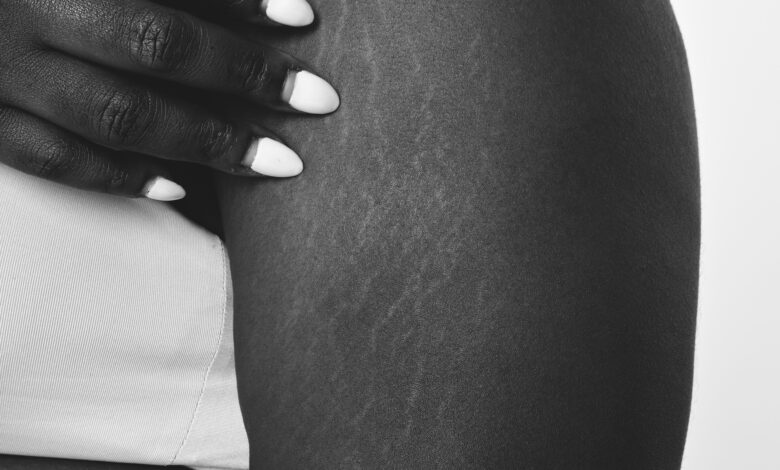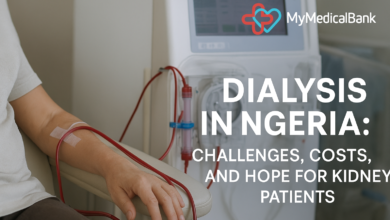Understanding Stretch Marks: Causes, Signs, and 5 Powerful Strategies to Minimize Their Appearance

Table of Contents
Stretch marks are long, narrow streaks, stripes, or lines that develop on the skin. They occur when the skin is suddenly stretched and are extremely common.
Anyone can develop stretch marks, although they tend to affect more women than men.
They can occur on a range of body parts, including the stomach, thighs, hips, breasts, upper arms, and lower back.
This type of scarring happens when the skin cannot resume normal form after a period of intense growth, often due to pregnancy, weight gain, weight loss, or puberty. Over 50 percent of women experience stretch marks during pregnancy.
Stretch marks are very common — estimates suggest up to 90 percent of people have them. They commonly appear during or after pregnancy or after other sudden or rapid changes in your weight. For example, rapidly growing adolescents Trusted Source might notice some stretch marks.
These marks can appear just about anywhere, but they’re most common on your stomach, breasts, upper arms, thighs, and buttocks.
When you touch them with your fingers, you might feel a slight ridge or indentation on your skin. They could also feel itchy or sore.
Stretch marks aren’t harmful to your health. Like other scars, they can be permanent, but they may change and fade over time.
Signs of stretch marks
The appearance of your stretch marks can depend on a combination of variables, like:
- Your natural skin tone
- Your skin’s health and elasticity
- The body part affected
Generally speaking, these lines have a different color and texture than your skin. Their color can range from purple to red to light gray or whitish.
Signs and symptoms of stretch marks include:
- Indented lines or streaks on your skin, which can vary in length and width
- Pink, purple, red, bluish, or dark brown streaks — these color marks can vary, depending on your skin color
- Thinned, glossy lines in your skin that may appear whitish over time
- Skin itching and irritation before stretch marks appear
What causes stretch marks?
Stretch marks happen for two main reasons:
- Stretching skin
- An increase of cortisone in your system
Cortisone is a hormone naturally produced by your adrenal glands. Having too much of this hormone, though, can lead to a loss of skin elasticity.
Stretch marks also become more common in certain circumstances:
- Many people experience stretch marks during pregnancy as the skin stretches in various ways to make room for the developing fetus. This continual tugging and stretching can cause stretch marks.
- Stretch marks sometimes appear when you rapidly gain or lose weight. Teenagers may also notice stretch marks after a sudden growth spurt.
- Corticosteroid creams, lotions, and pills can contribute to stretch marks by decreasing your skin’s ability to stretch.
How to get rid of stretch marks
Many products and procedures promise to minimize the appearance of stretch marks, or even make them disappear completely. To date, though, little evidence supports the effectiveness of these products.
Some suggestions you might have come across include:
- Moisturizing:
Plenty of moisturizers claim to minimize or get rid of stretch marks, but there’s no evidence to back these claims. Most research suggests, in fact, that applying moisturizer to stretch marks has no effect on their appearance. If you’d still like to give it a try, the American Academy of Dermatology recommends gently massaging it into new stretch marks over the course of several weeks.
- Self-tanning lotion:
According to the , applying self-tanner to your stretch marks offers a temporary way to minimize the difference in color between your typical skin tone and the color of your stretch marks.
- Prescription creams:
Some research suggests certain topical treatments available by prescription may help make early stretch marks less noticeable. These include hyaluronic acid and tretinoin, a synthetic version of vitamin A.
Medical treatments for stretch marks
Stretch marks often fade with time.
If you don’t want to wait, some treatments can help improve your appearance. Just keep in mind that no treatment can make stretch marks disappear completely.
A dermatologist can offer more guidance on professional options for minimizing the appearance of stretch marks, including:
- Tretinoin cream: Also known as Retin-A and Renova, this works by restoring collagen, a fibrous protein that helps give your skin elasticity. It’s best to use this cream on recent stretch marks that have a red or pink appearance. This cream may cause skin irritation. If you’re pregnant, you shouldn’t use tretinoin cream.
- Hyaluronic acid cream: This may help when applied consistently to early stretch marks. Hyaluronic acid is generally considered safe for most people to use.
- Pulsed dye laser therapy: This treatment encourages the growth of collagen and elastin. This therapy typically works best on newer stretch marks. It may cause some skin discoloration if you have a darker skin tone.
- Fractional photo thermolysis: This uses a laser to target small areas of your skin. It works similarly to pulsed dye laser therapy, with less potential for skin damage.
- Microdermabrasion: This involves polishing the skin with tiny crystals to reveal new skin under the more elastic stretch marks. Microdermabrasion may, in some cases, help improve the appearance of older stretch marks.
- Excimer laser therapy: This stimulates skin color (melanin) production so that stretch marks match the surrounding skin more closely.
Again, there’s no guarantee that any medical procedure or prescription medicine can cure stretch marks. Keep in mind, too, that these procedures do carry some risk of side effects, including swelling, skin irritation, and redness.
Professional treatments can also get fairly expensive.
The average cost of these procedures can range from around $167 for microdermabrasion to more than $2,000 for laser therapies, according to a report from the American Society of Plastic Surgeons.
When to connect with a dermatologist
Stretch marks happen naturally, and the marks themselves don’t pose any cause for concern.
That said, since they can happen as a sign of underlying health conditions, it never hurts to ask a dermatologist about your stretch marks — especially if you’ve noticed other unusual symptoms, such as:
- Unexplained weight gain
- Skin that seems thin, bruises easily, or heals slowly after injuries
- Muscle weakness and fatigue
- A general sense of unwellness
Working with a dermatologist might also have benefits when your stretch marks bother you to the point where they lead to emotional distress or make you feel reluctant to bear your arms, legs, stomach, or other body parts.
Conclusion
Stretch marks can be unsightly, but they are a common and often temporary problem.
They pose no long-term health risks, and treatment is normally intended to improve the self-image of the person with stretch marks.
Stretch marks often fade over time and become unnoticeable. For women who develop stretch marks in pregnancy, these usually become less noticeable around 6 to 12 months after giving birth.
Makeup can be used to conceal stretch marks on more exposed areas of the body while they are more pronounced.
.Facebook | Instagram | Linkedln| Youtube | Get Direction To Our Office



